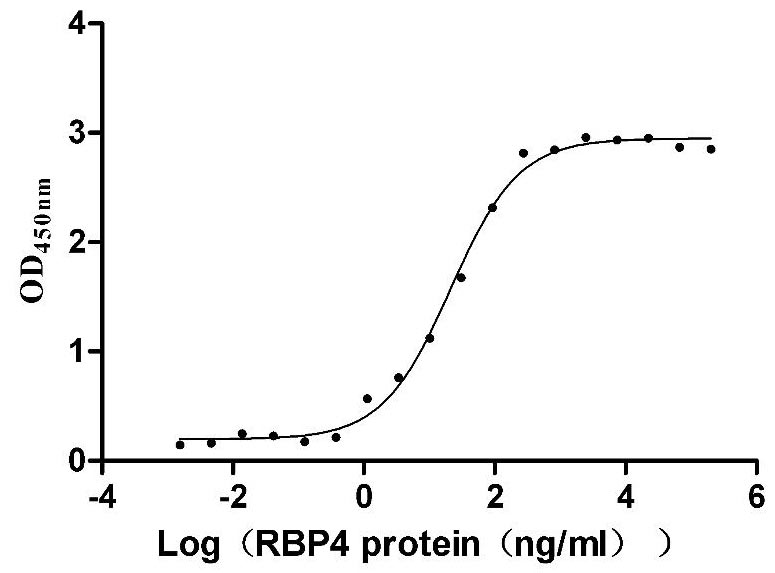Recombinant Mouse Fibroblast growth factor receptor-like 1 (Fgfrl1), partial
-
货号:CSB-YP008650MO
-
规格:
-
来源:Yeast
-
其他:
-
货号:CSB-EP008650MO
-
规格:
-
来源:E.coli
-
其他:
-
货号:CSB-EP008650MO-B
-
规格:
-
来源:E.coli
-
共轭:Avi-tag Biotinylated
E. coli biotin ligase (BirA) is highly specific in covalently attaching biotin to the 15 amino acid AviTag peptide. This recombinant protein was biotinylated in vivo by AviTag-BirA technology, which method is BriA catalyzes amide linkage between the biotin and the specific lysine of the AviTag.
-
其他:
-
货号:CSB-BP008650MO
-
规格:
-
来源:Baculovirus
-
其他:
-
货号:CSB-MP008650MO
-
规格:
-
来源:Mammalian cell
-
其他:
产品详情
-
纯度:>85% (SDS-PAGE)
-
基因名:Fgfrl1
-
Uniprot No.:
-
别名:Fgfrl1; Fgfr5Fibroblast growth factor receptor-like 1; FGF receptor-like protein 1; Fibroblast growth factor receptor 5; FGFR-5
-
种属:Mus musculus (Mouse)
-
蛋白长度:Partial
-
蛋白标签:Tag type will be determined during the manufacturing process.
The tag type will be determined during production process. If you have specified tag type, please tell us and we will develop the specified tag preferentially. -
产品提供形式:Lyophilized powder
Note: We will preferentially ship the format that we have in stock, however, if you have any special requirement for the format, please remark your requirement when placing the order, we will prepare according to your demand. -
复溶:We recommend that this vial be briefly centrifuged prior to opening to bring the contents to the bottom. Please reconstitute protein in deionized sterile water to a concentration of 0.1-1.0 mg/mL.We recommend to add 5-50% of glycerol (final concentration) and aliquot for long-term storage at -20℃/-80℃. Our default final concentration of glycerol is 50%. Customers could use it as reference.
-
储存条件:Store at -20°C/-80°C upon receipt, aliquoting is necessary for mutiple use. Avoid repeated freeze-thaw cycles.
-
保质期:The shelf life is related to many factors, storage state, buffer ingredients, storage temperature and the stability of the protein itself.
Generally, the shelf life of liquid form is 6 months at -20°C/-80°C. The shelf life of lyophilized form is 12 months at -20°C/-80°C. -
货期:Delivery time may differ from different purchasing way or location, please kindly consult your local distributors for specific delivery time.Note: All of our proteins are default shipped with normal blue ice packs, if you request to ship with dry ice, please communicate with us in advance and extra fees will be charged.
-
注意事项:Repeated freezing and thawing is not recommended. Store working aliquots at 4°C for up to one week.
-
Datasheet :Please contact us to get it.
靶点详情
-
功能:Has a negative effect on cell proliferation.
-
基因功能参考文献:
- FGFRL1 contains three extracellular Ig-like domains and a single transmembrane domain. It lacks the intracellular tyrosine kinase domain, but contains a short intracellular tail with a peculiar histidine-rich motif.The reason why this motif was conserved during evolution in most species, but not in mice, is not clear. PMID: 25934085
- FgfrL1 is specifically required for embryonic development of slow muscle fibers. PMID: 25172430
- Evidence that the novel receptor FGFRL1 signals indirectly via FGFR1. PMID: 24026051
- FGFRL1 does not function as a decoy receptor in beta-cells, but rather it enhances ERK1/2 signaling through association of SHP-1 with the receptor's intracellular SH2-binding motif. PMID: 23640895
- The expression profiles of wildtype and Fgfrl1 mutant kidneys, were compared to identify genes that act downstream of Fgfrl1 signaling during the early steps of nephron formation. PMID: 22432025
- Fgfrl1 null mice have reduced expression of Tpm3, sarcomere genes and Lrtm1 in the diaphragm. PMID: 20024584
- FGFRL1 is indeed a decoy receptor for FGFs. PMID: 19920134
- FGFRL1 expression is very low in mouse embryos of day 6 but steadily increases until birth. PMID: 16525717
- Mice with a targeted disruption of the Fgfrl1 gene die at birth due to alterations in the diaphragm. PMID: 17986259
- These data support a wider role for Fgfrl1 in development, implicate FGFRL1 insufficiency in Wolf-Hirschhorn syndrome, and provide a novel animal model to dissect the complex aetiology of this human disease. PMID: 19383940
显示更多
收起更多
-
亚细胞定位:Cell membrane; Single-pass membrane protein.
-
组织特异性:Highly expressed in the kidney, brain and lung. Weakly expressed in the muscle, thymus, lymph node, stomach, intestine, colon and liver. Expressed in fetal cartilaginous structures like the nasal cartilage, the ribs and the sternum as well as in the carti
-
数据库链接:
KEGG: mmu:116701
STRING: 10090.ENSMUSP00000013633
UniGene: Mm.35691
Most popular with customers
-
Recombinant Macaca fascicularis Angiotensin-converting enzyme (ACE2), partial (Active)
Express system: Mammalian cell
Species: Macaca fascicularis (Crab-eating macaque) (Cynomolgus monkey)
-
Recombinant Mouse Transthyretin (Ttr) (Active)
Express system: Mammalian cell
Species: Mus musculus (Mouse)
-
Recombinant Human Claudin-6 (CLDN6)-VLPs (Active)
Express system: Mammalian cell
Species: Homo sapiens (Human)
-
Recombinant Human CD81 antigen (CD81), partial (Active)
Express system: Mammalian cell
Species: Homo sapiens (Human)
-
Recombinant Human Cytotoxic and regulatory T-cell molecule (CRTAM), partial (Active)
Express system: Mammalian cell
Species: Homo sapiens (Human)
-
Recombinant Human Carcinoembryonic antigen-related cell adhesion molecule 8(CEACAM8) (Active)
Express system: Mammalian cell
Species: Homo sapiens (Human)
-
Recombinant Human C-C chemokine receptor type 6(CCR6)-VLPs (Active)
Express system: Mammalian cell
Species: Homo sapiens (Human)




-AC1.jpg)














